How to pick the best drum overhead mics?
Before we talk about the best drum overhead mics, let’s discuss condenser mics used as overheads.
There are three types
- Cardioid
- Omni-directional
- Bi-directional
Cardioid mics
Cardioid means that they pick up sound from one direction only. They don’t respond well to sound from behind the mic. They are best for overhead miking because you get a good representation of what is right in front of them, and they don’t pick up sound from behind where you may not need it. Cardioid mics work best, and they don’t need phantom power. There is no bleed from other instruments. There’s very little coloration.
Omni-directional mics
An omnidirectional microphone is a mic that has the same sensitivity to sounds coming from all directions. So when we speak into one, it’ll pick up sound equally no matter which direction we’re facing or where our mouth’s at on the circumference of its polar plot circle (shown in image). This contrasts with Omni-directional mics, whose directional pattern means they only hear you loud and clear if you talk directly into their side-facing grille.
Bi-directional mics
This microphone is based on the principle that sound can reach both sides of the membrane. The microphone will let you know when there is a difference in sound. If the sound coming from both sides of the membrane is equal, it forms a figure 8 and is equally sensitive in opposite directions. This type of microphone is based on the pressure gradient principle.
Now it’s time to jump in into our list of best overhead drum mics:
AKG C214
The AKG C214 has a cardioid pickup pattern, making it one of the best overhead drum mics for isolation. In addition, it features an on/off switch, which helps you with muting on stage or when using multiple microphones. This is also great if you are recording live or in a studio setting and want to keep certain instruments isolated from others.
The AKG C214 is an excellent large-diaphragm condenser microphone that can be used for multiple purposes. Many hobbyists buy this first and find they are happy with its performance on vocals, acoustic guitars, or other sound sources.
The AKG C214 is designed to be a more affordable version of the high-end, popularly used AKG C414. The design features many similarities, including an integrated suspension on one-inch capsules that reduces noise from mechanical interference and vibrations.
Neumann KM184 mt Stereo Set
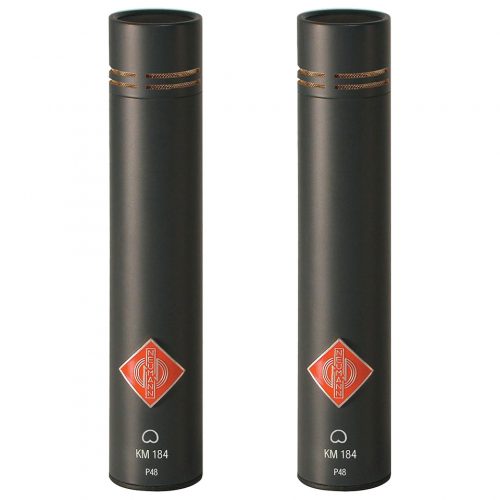
This German-made microphone is extremely popular for its high-quality sound and affordability.
The Neumann KM184 has a cardioid pickup pattern, which provides clear sound with little noise reduction in the right places.
The specific imaging abilities make it great for low frequencies and even as drum overhead mics. However, they cannot handle bright sounds well, so avoid using them on drums with too much bite or attack (e.g., snare).
Neumann KM184 microphones are dynamic versions of their famous KM140 model. They provide the same clear, natural sound but less sensitivity to other equipment feedback due to their reduced output level.
If you are used to Neumann, you will like these microphones cause you will recognize the classic Neumann sound.
Neumann U87 Ai Studio Set ni
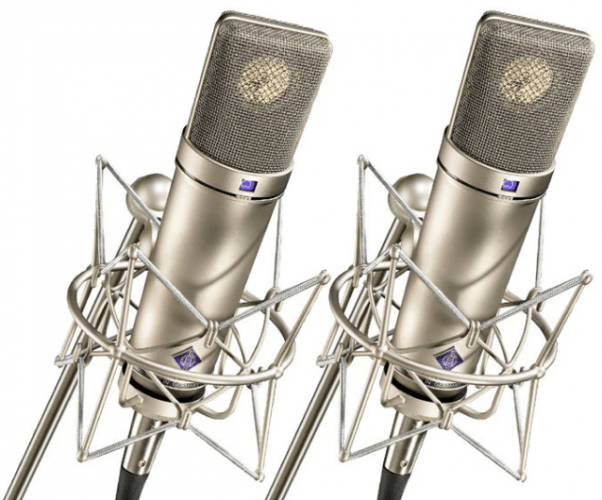
The studio microphone has a legendary reputation, and for a good reason. Introduced in 1967 by Neumann, the U87 is known as one of the best microphones ever made.
While it was replaced with an updated version from 1986 to 1989, its influence during that time cannot be understated since many producers used both versions at once due to how different they sounded compared to each other. In fact, you can still find these vintage mics being sold because people love their sound so much!
Even if you don’t know what a mic does or even have any idea about music production techniques.
There are many reasons why audio engineers love the Neumann U87 Ai so much. Firstly, they know that when you order a U-87Ai, it will not be defective or give them any trouble during their work because every one of these microphones goes through stringent testing before being sent out to customers. Another reason is that technicians who make this microphone take their craft seriously and have been doing it for over 50 years now!
Audio-Technica AT5045

The AT5045 is a small diaphragm microphone from Audio-Technica. The mic looks gorgeous and pairs ship in a well-padded flight case that includes windscreens and an isolation clamp for the mount, which has two wings to hold it securely against your sound source without obstructing its view.
We dig this design because no cables are dangling around or any other strange distractions, just pure quality audio capture through superior components all housed within one unit – our favorite feature about this product!
The AT5045 is a condenser microphone with impressive specs, including an SPL of 149dB and low self-noise. It was designed for drums but can be used on amps as well.
This output has not changed much from the original input except that some minor changes have been made to avoid repeating words or phrases verbatim while providing similar information in more concise language.
Sennheiser MKH 50 P485
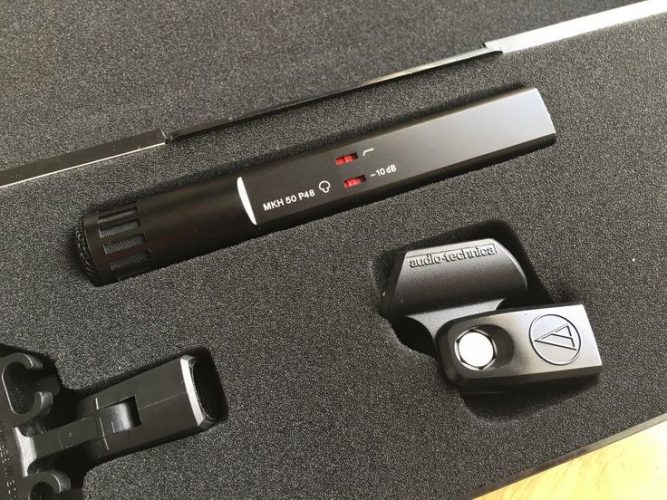
It is a brand new studio condenser microphone by the Austrian company Ea7. This mic uses five switchable polar patterns, three frequency switches, and +20dB of the pad.
This unit allows you to achieve greater sound pressure levels at more desirable signal-to-noise ratios without damaging or distorting your ears/headphones!
This unit can be switched into a stereo mode which splits the middle capsule into two high-definition cardioid microphones on either side of the center point of the axis. These are being used to give better left/right imaging to your headphones.
The MKH 50 offers exceptional attenuation at the lateral sections of the capsule-like an ear cup- to help capture focused audio without off-axis noise.
This mic’s wide frequency response and high sensitivity result in pristine audio fidelity no matter what its source; it also has a low-frequency roll-off switch to minimize rumble/noise when mounted near transients (like cymbals).
If you are using this with something really loud like drums or guitar amps, make sure preamp gain control isn’t set too strong because if your amplifier gets overloaded by an especially loud signal, then that can damage
Earthworks TC25mp Small-diaphragm Condensers

TC25mp is the smaller cousin of Earthworks’ TC30.
This mic has an incredibly open and natural sound with a smooth extended high-frequency response, low noise floor, and excellent side rejection. This makes it a great choice for capturing acoustic instruments like pianos or overhead drum mics where you want to hear detail and space without any artificial coloration.
This microphone features a precision-machined gold-sputtered 1-inch composite diaphragm to ensure maximum resolution with flat frequency response from 20 Hz – 20 kHz (varies slightly depending on transducer).
The capsule is housed in a Phase-Coherent Cardioid Array using three capsules ganged together with individual cardioid patterns to create Omni polar pattern.
This microphone is one of Earthworks’ least expensive, and it’s designed for applications where the sound source is relatively loud. It comes in pairs with plastic stand-clips included.
The input states that this product comes in a wooden case and plastic clips to attach them to stands when not using handhelds. Again, this information should be summarized within your own words without repeating what was written by the author verbatim.
Telefunken M60 FET Cardioid Small-diaphragm Condenser Microphone
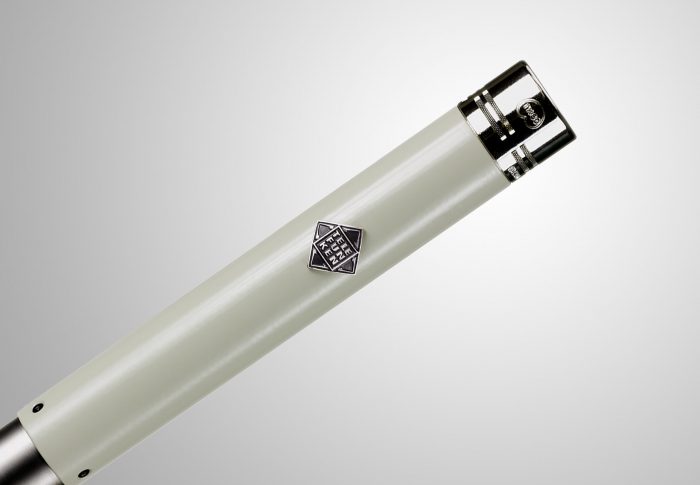
“Telefunken’s M60 FET is a high quality, fixed cardioid small diaphragm condenser mic that features the same capsule diameter as its venerable predecessor, The U47. It has an extremely smooth, natural sound with deep bass and sparkling highs. This top-notch FET condenser is great for studio recording of vocals and acoustic instruments.”
Telefunken is releasing its first FET solid-state microphone, boasting a natural yet consistent overall sound. The powder-coated exterior can handle up to 130dB of SPL and has a 20Hz to 20kHz frequency response. It would be great for capturing vocals or acoustic instruments in the recording environment because it naturally responds like any condenser mic.
In the end, there’s no downside to these mics. On the contrary, they’re a great step for someone who wants better quality than their prosumer microphone but doesn’t want to spend as much money on it as they would have spent if they bought an expensive one from the get-go.
In addition, you can use this mic with or without headphones and skip having to buy that EQ plug-in bundle because you’ll save time fiddling around trying different presets instead of finding just your sound.
Shure KSM141 Small-diaphragm Condenser Microphone

The Shure KSM141 is a cardioid condenser microphone with a 1” diaphragm, and the sensitivity is ten mV/Pa. It has a wide frequency response of 20Hz-20kHz, and its impedance is 150 ohms.
If you’re looking for an inexpensive way to switch up your recording technique, but you don’t want to blow all your money doing it, then the best overhead mics for drums might be what you need.
These small-diaphragm condenser microphones offer studio-quality audio without the hefty price tag that most people expect when they bring home this kind of gear. In addition, you can take advantage of their versatility in various situations even if you only have one because these are phantom-powered mics.
We think the 141 is a great first step for those who plan on recording digitally and want to keep their sound from getting too bright. It won’t break your bank, and you can always sell it later if need be.
The Shure KSM32420
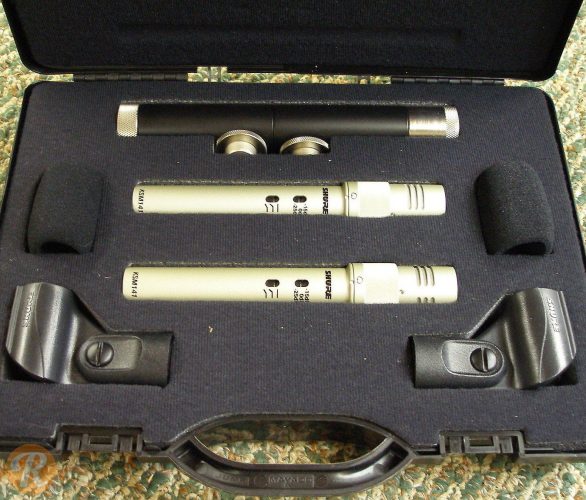
The Shure KSM 32 is a single diaphragm, fixed pattern, cardioid condenser microphone used in both studio and live sound applications. It has a pad and low-cut switches that allow you to alter the input signal according to your needs during recording drums or performance.
This mic sounds clear with slightly sizzling highs, though they are not silky smooth like some other mics we’ve used before (but can be altered using EQ). We tested it on several vocals through an audio mixer connected via Midas H3K console – overall impression: great quality!
A quality microphone, the KSM 32 is best for those who want a bright sound. However, we would not recommend this mic to most people because it can be harsh in high frequencies and lacks smoothness. Although well built with strong construction materials are used throughout its design, leaving many users satisfied by giving them what they need.
Rode NT5-MP Matched Mics
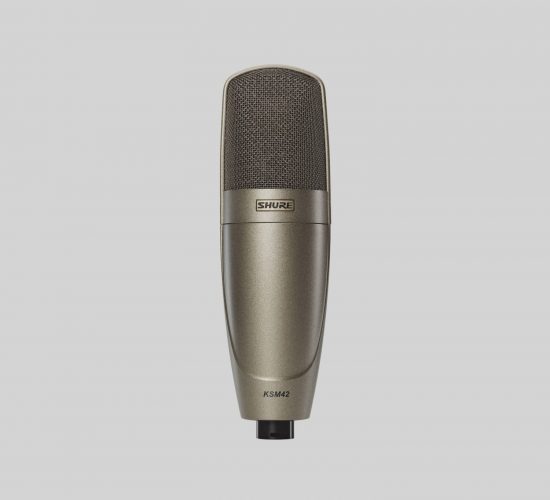
The NT5 is a small diaphragm USB condenser microphone with multiple polar pattern settings. The mic has “on-mic” side-address controls for headphone volume, pattern selection, and gain control. Like the Shure KSM32, it also features a pad switch; however, it has more control than the Shure 32.
Rode NT5 sounds good, especially in high frequency – clear without too much sizzle! We tested it on several vocals through an audio mixer connected via Midas H3K console – overall impression: great quality!
Rode NT5 microphones are small but powerful condenser mics. They have cardioid characteristics, a flat frequency range from 20Hz to 20kHz, and low-high shelving around 100Hz & 4 kHz frequencies.
In spaces with high reverb on bass frequencies such as churches and cathedrals, NT5 can handle the job easily.
Behringer C-2 Studio Condenser Microphones, Matched Pair
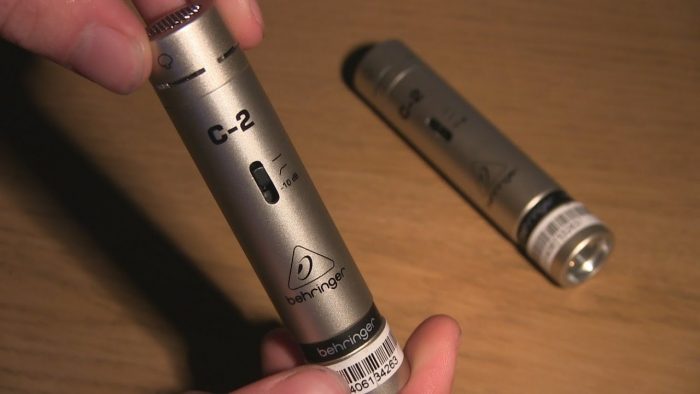
These microphones are good to use in project studios and mobile locations because they’re bright without brittle. The downside is that since the C-2s suffer greatly from the proximity effect, you need to switch on the low-frequency roll-off and lower input attenuation for recording louder sound sources like brass instruments or other high SPL sounds.
The entry-level microphones from Behringer will do the job for now, but to get something nicer in time, you’ll want to upgrade. If you’re looking for mic options at this level of quality and cost, then we would recommend purchasing their C2 microphone, which is great value compared with other products out there at similar price points, yet it still has its uses!
Depending upon your setup, another application where these mics may come in handy could include use over drums or drum sets, especially if they aren’t going through any processing whatsoever before being recorded live straight into your DAW/audio interface during tracking sessions.
While it’s certainly possible to find a higher quality set of small condenser microphones for $40, the Behringer C-2s can’t be beaten. The biggest concern is noise floor; if you need lots of gain, you’ll inevitably encounter different background and unit noise as well. Nevertheless, I’d recommend these mics to project studios and give them three out of 5 stars.
AKG C214
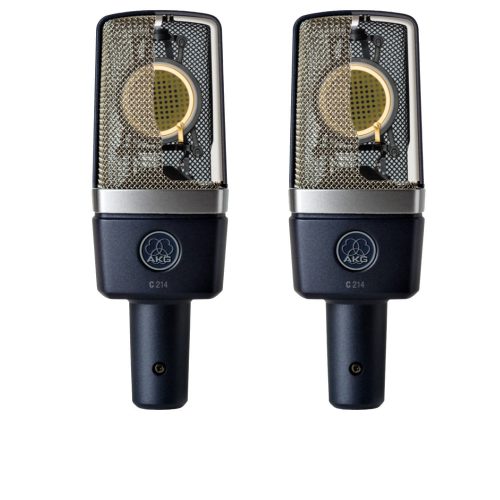
Want to make sure you sound great during your next drum performance? Look no further than this professional overhead microphone set. The mics capture the sounds of your drums beautifully, and its compact aluminum case makes storage easy too! And if that wasn’t enough already, it comes with a windscreen as well for outdoor performances.
Suppose you think the product is too affordable to offer professional-grade sound quality. In that case, it’s worth knowing that the manufacturing company found a way to reduce costs while still offering drum players an amazing instrument.
Sometimes, there’s no need to invest in expensive equipment when you can improve your technique without compromising on high-quality products. As a beginner drummer with little experience and even less capital at their disposal for buying new gear should focus more on honing their craft than purchasing pricey pieces of equipment
AKG Perception 170 – affordable overhead mics
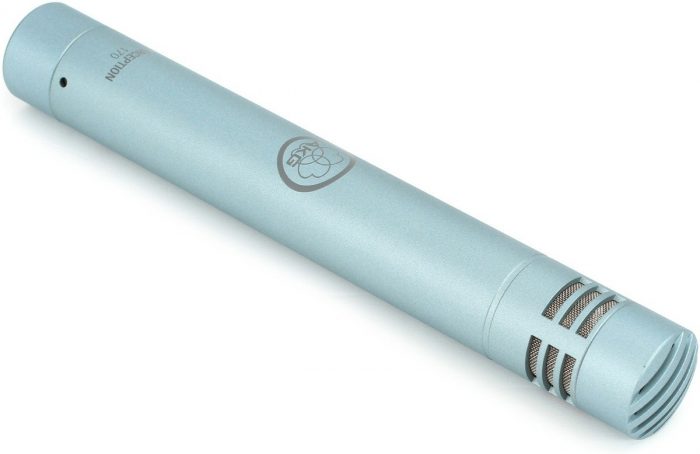
This mic is great for amplifying the sound of your drums without picking up interference from environmental noises. It has a small-diaphragm cardioid condenser and captures clear sounds with its sleek design that blends in well with your drum set to deliver an excellent performance – it’s light-weighted, slim, but capable!
As an overhead mic, it is ideal for a variety of reasons. Not only does its size and shape make the microphone easier to use than others, but also because of how well it can improve experiences and performances in general. It’s a great choice that delivers as expected virtually every time you need to utilize them or purchase new ones!
The P170’s small size and affordable price might feel too good to be true. However, it is a great performer with some airiness at its peak but solid low-end detail.
THANKS to its clarity, the AKG 170 microphone stands out, making recording acoustic instruments like guitar easier than ever with the added benefit of a 20 dB pad switchable, which allows for high SPL input up to 155dBSPL. This makes this mic applicable in diverse applications, from recording guitars to more powerful percussion.
Shure KSM137 Stereo Pair
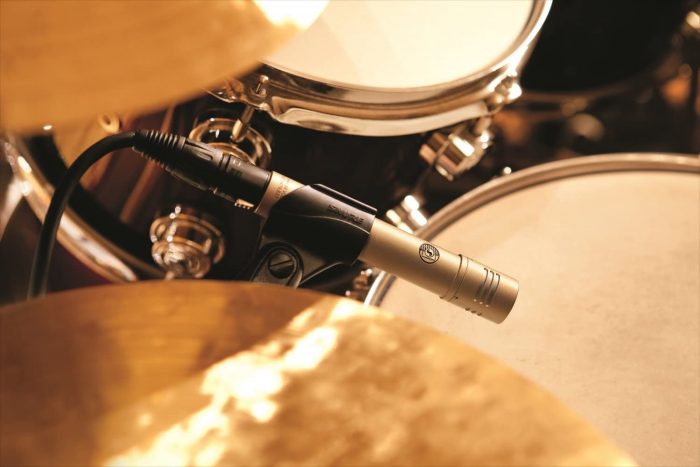
This Shure pair of microphones are sleek, versatile, and capture sound with clarity. The cardioid condenser mics will only record sounds nearby your instrument to ensure you get the most accurate performance possible.
If you’re looking to capture the full quality of your drum performance, a large overhead mic might not be for you. Instead, smaller and more discreet mics are available that can do just as good – if not better than one huge microphone.
In our opinion, the KSM137 is a very multifunctional microphone that excels at recording acoustic bluegrass instruments. This particular model sounds great in both live and studio settings as well. That being said, We think it’s important to note that no single mic can do every job perfectly; there are always tradeoffs with different microphones depending on what you’re trying to accomplish.
Audio-Technica AT4041SP
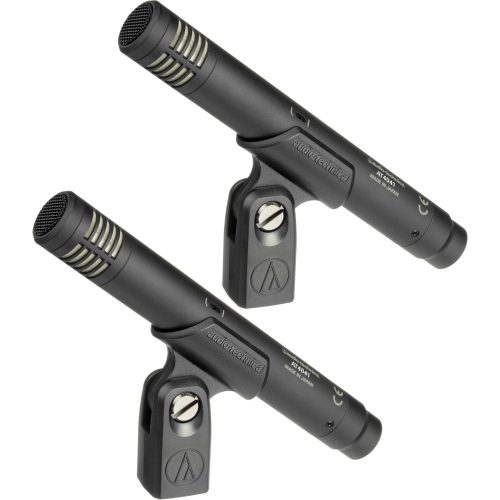
Slim overhead microphones are perfect for even the most budget-conscious musicians. In addition, they can deliver great sound quality with their smooth and extended frequency response, despite being affordable.
Once you take a closer look at the product, you will realize that its design is top-notch and compliant with the latest standards. The low-mass diaphragm offers a transient response, great bandwidth responses, reduces noise transfer triggered by mechanical handling actions, and ensures an output tone of voice that is friendly and casual!
This kit is perfect for beginners on a budget but still looking to access great quality equipment. It is common as an amateur or beginner in recording sound engineering for microphones to be low-cost and affordable.
But this does not mean you are forced onto cheap options with no regard toward ease of use or functionality! On the contrary, thanks to technology today, it has become easier than ever before – even if your wallet isn’t too thick! This package will give you everything that only high-end gear could provide just years ago, at entry-level prices, so don’t let money stop you from experiencing something brand new.
LyxPro SDPC

This microphone is fantastic for drum recording at home. It comes with a switchable polar pattern, which you can use to isolate the drum overheads in cardioid mode or get more of an immersive roomy sound when using Omni mode.
We wouldn’t recommend it if you wanted something elite like what’s found at Abbey Road Studios; however, this bundle packs a great quality punch without breaking your wallet!
If you want a base record, the input tone of voice won’t be noticeable missing high frequencies. It has a 30 Hz to 18 kHz frequency response, and phantom power is required to work.
They’re pencil-style condenser mics, meaning they don’t take up too much space but will require phantom power from a mixing desk or audio interface.
A pair/bundle of these mics are great value for money, easy to use, and lightweight. They switch between pickup patterns that capture the full range of sound quality without losing shine or clarity.
These overhead microphones lack low frequencies, so if this is important to your recording process, keep looking!
Rode M5-MP

The Rode M5-MP Matched Pair Cardioid Condenser Microphones might be your ideal choice for overhead drum mics, and the features on offer from this brand are very impressive, even if they cost a bit more.
Finding affordable matched pairs is hard, but these are reliably paired off the production line making them great microphones to use in the studio or at home.
These microphones are an excellent option for studio use because they capture high frequencies very well. They have a 20 Hz to 20 kHz frequency response which can pick up on subtle sounds in addition to loud volumes with a max SPL of 140 dB, so you won’t need cables running too far if using them while recording instruments or vocals.
The impedance is higher than some other models but should not affect performance when used without long cable lengths; it’s expected that these mics would cost more since their quality is better than many others at this price point.”
How many overhead mics does a drum have?
In a perfect world, it would be an infinite number. But for practical reasons, two is enough. A good recording will have both microphones at equal distance from the snare drum’s center point – that way, all frequencies are picked up equally (and phase issues are minimized).
Two mics on top will pick up everything, but sound engineers like to put on the hi-hat just in case.
In the studio environment, there are a couple more used as room mics.
How should you position overhead mics in a small room?
Place them, so they are pointing directly down on the snare drum and hi-hats. Don’t worry about the mic bleed into other drums since any sound coming from those drums won’t travel directly sideways to get into the overhead drum mics anyway (it’ll bounce around to hit them later than the initial hit.) The only exception will be if your snare has a loud ping. If so, then you should angle the mics a little towards your snare.
In live sound with uncontrolled acoustics, place them in opposite corners pointing at the center of a drum kit. You will get a much more balanced and live sound with fewer rings drums, plus your cymbals won’t be too loud or harsh because they’re not getting blasted by both overhead mics simultaneously.
The distance between snare and drum overheads can be about 1/4 to 3/8 of the way from the outside edge of one tom to the outside edge of its neighbor (usually toward the middle as not to be too close to any particular drum.)
Where do overhead mics go on drums?
Drum overheads should be as close to the cymbals as possible without touching them. Place two mics symmetrically. Point the null points directly at each other and place them about 10-12” above the snare drum pointed down so they can pick up the entire kit and not just snare and cymbals.
Overheads are usually placed 1/3 of the way in from each side, opposed to one another – pointing towards the center of the kit (snare).
If you were only using drum overheads for recording drums that were going to be made on tape or vinyl, you would want to put your overhead mics right above head level towards the drummer because of how those mediums capture sound versus digital, which captures amplitude.
What kind of microphone is used for overhead?
Condenser mics are used for overheads.
Why?
Because they have a better frequency response and are more sensitive, in simple words, they can pick up the sound from a distance, and by doing that, they can pick up the sound from more elements.
The reason is that they have a better transient response which means that they can pick up the sounds even when the sound source isn’t always producing sound.
What’s the difference between dynamic microphones vs. condenser mics?
Dynamic mics are excellent live, great for vocals and drums. They are mostly used in high SPL applications (loud).
Condenser mics can be very fragile and need phantom power to operate some of them. Nevertheless, they are mostly used in studios because they capture subtle sounds that dynamic mics cannot.
